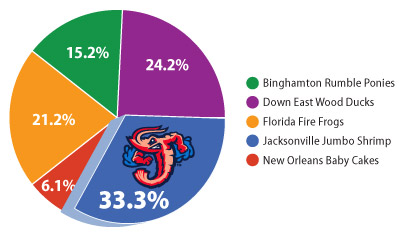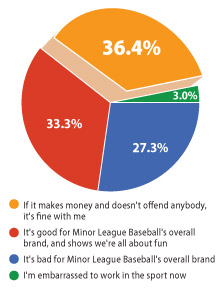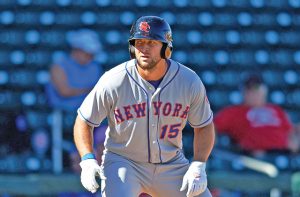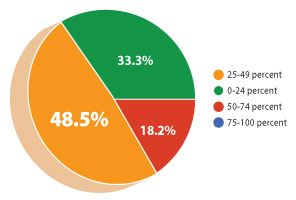Last year at this time, Baseball America presented our Best of the Minors survey, which polled minor league executives and broadcasters about the sport’s superlatives. This year, we’re switching it up a bit. Instead of asking for the their take on the best mascot (Wool E. Bull), the best in-park entertainer (Zooperstars!) or the best major league broadcaster prospect (Richmond’s Jay Burnham), we’ve asked the same group of people a variety of questions related to the biggest issues in the minors right now.
This was the offseason of rebranding, so we asked executives which new team nickname they liked the best and which one they liked the least. We also tried to get a sense of how they feel about the rebranding trend as a whole. Is it too much? Is it just getting started? And how does it reflect on the minor leagues overall?
You might also have heard that a Heisman Trophy winner and former NFL quarterback is giving baseball a try more than a decade after he starred in the sport in high school. He’s starting the season in low Class A, and you can bet there are opinions on his attempts get to the major leagues.
There are also questions about pace of play and whether the rules enacted in 2015 have had a positive effect or whether more needs to be done to speed up the game, even in the minor leagues.
All that and more can be found in this year’s minor league survey.
Which of the new team names for 2017 is your favorite?
Five new team names are set to debut in 2017 (we’re discounting the Carolina League’s Buies Creek Astros because they’re going to get their official name when they move into their new park in Fayetteville, N.C., in 2019), and the opinions on them have run the gamut. The Jacksonville Jumbo Shrimp (Southern) took the early vote and held off the Down East Wood Ducks (Carolina) down the stretch.
“I think the thing for me is, if you’re going to rebrand, you need to own that space, that word, in your fans’ minds,” one minor league general manager said. “They own Jumbo Shrimp. In the sports world, they own it–it’s theirs. And there’s so much that can be done with that brand, whether you’re playing off the size or you’re playing off the animal, there’s just a lot you can do with the brand.”
Which of the new team names for 2017 is your least favorite?
On the other end of the spectrum, there are the New Orleans Baby Cakes (Pacific Coast), which took just 6.1 percent of the vote for favorite new logo but garnered more than half of the votes for least favorite.
“It’s just something about Baby Cakes that doesn’t ring a bell,” one minor league executive said. “It sounds like you’re going down a path that you don’t want to go down.”
Overall, what do you think of the minors’ rebranding trend?
Obviously, rebranding isn’t new in the minor leagues. Teams are allowed to change their identities every three seasons, and a great deal have taken advantage over the past decade or so. This year’s spate of new names and logos took a noticeable turn toward the wacky, however, becoming a polarizing topic among minor league front offices.
Those surveyed were given four choices to summarize their opinion, and the winner was: “If it makes money and doesn’t offend anybody, it’s fine with me.” Taking second place was “It’s good for Minor League Baseball’s overall brand and shows we’re all about fun,” which shows the trend has been viewed as mostly positive. One third of the respondents, however, weren’t as pleased. One went so far as to pick the option saying “I’m embarrassed to work in the sport now.”
Tim Tebow’s foray in the minor leagues is _________ for baseball

‘Uncouth cash grab’? That’s how one executive described the Mets signing Tim Tebow (Photo by Mike Janes)
The results here were split into three camps: Those who like it, those who don’t and those who don’t have a strong opinion. One answer that came up multiple times was “profitable,” which respondents viewed as both good and bad. Some executives believed that their job in the minor leagues is to bring in as many fans and sell as much merchandise as possible, while others saw Tebow’s signing by the Mets as a pure financial move that dilutes the product. One executive surveyed referred to the whole phenomenon as “an uncouth cash grab.”
Based on the promotional schedules you’ve seen so far, which bobblehead will be the best of 2017?
There were many nominees here, including multiple votes for Akron’s Enrico Pallazzo (as portrayed by Leslie Nielsen in the movie “The Naked Gun”) and for Fresno’s rendition of Giants all-star Madison Bumgarner arm-wrestling a grizzly bear. The winner, though, was Chattanooga’s depiction of Jackie Mitchell, the woman who pitched for the Lookouts in an exhibition game in 1931 and struck out Hall of Famers Babe Ruth and Lou Gehrig in succession.
Which promotion that debuted in recent years do you expect to become a staple in the future?
With a little bit of thought, we probably could have predicted the winner in this category. As mentioned earlier, minor league teams are only allowed a full rebrand (and the revenue boost that comes with it) every three years, and in actuality they do it far less frequently due to the cost involved.
There’s no limit on one-night switches, however, and teams have begun taking full advantage. This year alone, the Reading Fightin Phils (Eastern) will become the Whoopies (Aug. 7), the Aberdeen IronBirds (New York-Penn) will become the Steamed Crabs (Aug. 11), the Charlotte Knights (International) will become the Pitmasters (July 15) and the Brooklyn Cyclones (New York-Penn) will become the Slices (Aug. 4).
The idea isn’t new. The Bowling Green Hot Rods had a “What Could Have Been” night in 2009 when they became the Cave Shrimp for a day, but the trend has blown up in recent years, generating new merchandise and the corresponding revenue windfall.
What percentage of your fans do you believe come to the park for the game itself, as opposed to the overall atmosphere of a family-friendly night out?
The worst-kept secret in the minor leagues is that it’s not about the baseball at all. The game itself is what brings in the fans, but a good chunk of them are there for the atmosphere and a cheap night out rather than to concern themselves with the final score. Some are there for the game, but others are there for the bobbleheads, the mascots, the food and a night away from the grind of day-to-day life. Nearly half of respondents said they believe that between one-quarter and one-half of their nightly crowds are there mainly for the ballgame. Thirty-three percent believe that number was even lower, with between 0-24 percent coming to the park to root for the home team.
Do you ever anticipate advertisements appearing on minor league uniforms?
Though this question was open-ended, the response was decidedly one-sided. More than 80 percent of those surveyed believed that, yes, there would be advertisements on minor league uniforms sometime in the near feature. One executive noted that the NBA’s Boston Celtics and Philadelphia 76ers already have ads for General Electric and StubHub, respectively, and that baseball probably isn’t far behind.
“It’s a concept that maybe purists would have trouble with, and frankly I, myself, would probably have trouble with,” one general manager said, “but I think you’re seeing it all around us. You’re seeing it in Major League Soccer. You’re seeing it in the NBA and their D-League. At some point, I can’t imagine baseball’s going to be the only holdout.”
Is pace of play a problem in Minor League Baseball?
The AFL’s pace-of-play initiatives include a time limit between innings.
This is a hot-button issue these days. Major League Baseball continues to try new ways to speed up the game in an effort to keep viewers’ attention in an age where there are so many more forms of entertainment vying for attention. This season, MLB has proposed using international tiebreaker rules (like the ones you saw in the World Baseball Classic) in the Rookie-level Arizona and Gulf Coast leagues, and pitch clocks have been in play at Double-A and Triple-A since 2015 after a dry run in the 2014 Arizona Fall League. Even if fans view a game’s pace as a problem, however, executives might not see it that way. As one said in our survey, “Longer games mean more merchandise and revenue opportunities for clubs. I am all for longer games.”
If you believe pace of play is problem in the minor leagues, what are some things you’d suggest to speed up games?
Those who do have a problem with long games, however, have a variety of solutions to suggest. The idea that came up most often was further restricting the number of mound visits for each pitcher. That includes visits from the pitching coach, manager or catcher.
“We do not have pitch clocks in (our league), but the number of visits to the mound by a pitching coach should be cut down,” one executive said. “I understand it’s about player development, but at some point and time, the player needs to either pitch out of the jam or be pulled.”
Another idea brought up multiple times was simply enforcing the rules that prohibit hitters from stepping out of the batter’s box between pitches. Broadcasters who were surveyed noted that while the rule was on the books, it was rarely enforced by minor league umpires.



Comments are closed.